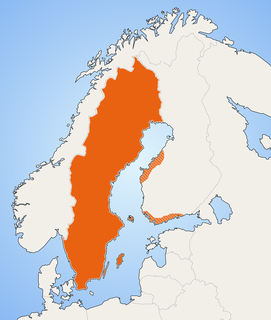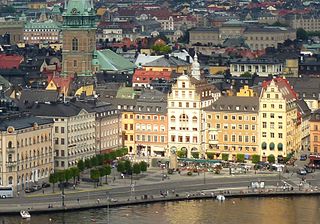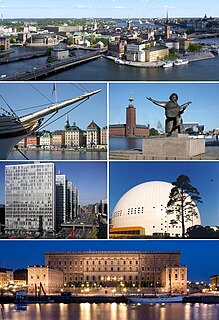
Stortorget is a small public square in Gamla Stan, the old town in central Stockholm, Sweden. It is the oldest square in Stockholm, the historical centre on which the medieval urban conglomeration gradually came into being. Today, the square is frequented by tens of thousands of tourists annually, and is occasionally the scene for demonstrations and performances. It is traditionally renowned for its annual Christmas market offering traditional handicrafts and food.

Trädgårdsgatan is a small street in Gamla stan, the old town of Stockholm, Sweden. It stretches west from Skeppar Olofs Gränd to Källargränd, just south of the Royal Palace and north of the square Stortorget. Forming a parallel to Slottsbacken and Köpmangatan, it is intercepted by Trädgårdstvärgränd. On the northern side of the street are gates leading to Bollhustäppan. It is named after the royal gardens once located along its northern side.

Skomakargatan is a street in Gamla stan, the old town of Stockholm, Sweden, Stretching between the square Stortorget and the streets Kindstugatan and Tyska Brinken, it forms a parallel street to Prästgatan and Svartmangatan.

Svartmangatan "Black Man Street") is a street in Gamla stan, the old town of Stockholm, Sweden. Stretching south-east from the central square Stortorget to Södra Benickebrinken and Norra Benickebrinken leading to the eastern main street Österlånggatan, it is intercepted by Kindstugatan, Tyska Skolgränd, Tyska Brunnsplan, Själagårdsgatan, Tyska Stallplan, and Baggensgatan, while forming a parallel street to Skomakargatan and Prästgatan. The name refers to the Blackfriar monastery once located at the southern end of the street.

Österlånggatan is a street in Gamla stan, the old town of Stockholm, Sweden. Stretching southward from Slottsbacken to Järntorget, it forms a parallel street to Baggensgatan and Skeppsbron. Major sights include the statue of Saint George and the Dragon on Köpmanbrinken and the restaurant Den Gyldene Freden on number 51, established in 1722 and mentioned in Guinness Book of Records as one of the oldest with an unaltered interior.

Kråkgränd is an alley in Gamla stan, the old town of Stockholm, Sweden. Stretching between Skeppsbron and Österlånggatan, it forms a parallel street to Bredgränd and Nygränd.

Brända Tomten is a small, triangular public square in Gamla stan, the old town in central Stockholm, Sweden.

Själagårdsgatan is a street in Gamla stan, the old town in central Stockholm, Sweden. Stretching south from Köpmangatan to Tyska Brunnsplan, it forms a parallel street to Baggensgatan. It crosses the small triangular square Brända Tomten and is intercepted by Kindstugatan, Tyska Skolgränd, and Svartmangatan.
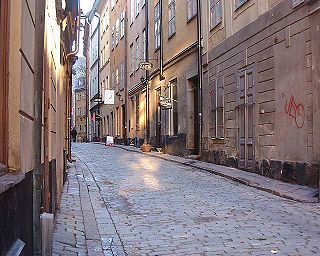
Kindstugatan is a street in Gamla stan, the old town in central Stockholm, Sweden. Stretching west from Brända Tomten to become Tyska Brinken in its western end, it is crossed by Svartmangatan and Skomakargatan.
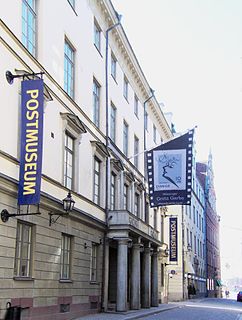
Lilla Nygatan is a street in Gamla stan, the old town of Stockholm, Sweden. Stretching from the square Munkbron south to Kornhamnstorg, the street in intercepted by Yxsmedsgränd, Kåkbrinken, Schönfeldts Gränd, Tyska Brinken, and Lejonstedts Gränd, while forming a parallel street to Stora Nygatan and Munkbrogatan.
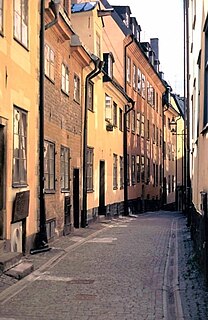
Prästgatan is a street in Gamla stan, the old town in central Stockholm, Sweden, stretching from a cul-de-sac west of the Royal Palace to the street Österlånggatan in the southern corner of the old town. Prästgatan forms a parallel street to Västerlånggatan, Trångsund, Skomakargatan, and Svartmangatan. It is intercepted by Storkyrkobrinken, Ankargränd, Spektens Gränd, Solgränd, Kåkbrinken, Tyska Brinken, Tyska Stallplan, Mårten Trotzigs Gränd, and Norra Benickebrinken.

Baggensgatan is a street in Gamla stan, the old town in central Stockholm, Sweden. Forming a southern extension to the street Bollhusgränd near the square Köpmantorget, it stretches to the southern end of Svartmangatan. It forms a parallel street to Själagårdsgatan and Österlånggatan, while being intercepted by Tyska Skolgränd.

Tyska Brinken is a street in Gamla stan, the old town in central Stockholm, Sweden. Extending Kindstugatan past the German Church down to the square Mälartorget, it is crossed by Skomakargatan, Prästgatan, Västerlånggatan, Stora Nygatan, Lilla Nygatan, and Munkbrogatan, while forming a parallel street to Schönfeldts Gränd and Lejonstedts Gränd.

Slottsbacken is a street in Gamla stan, the old town in central Stockholm, Sweden.
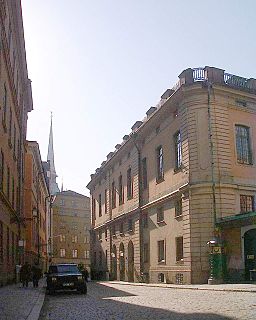
Källargränd is an alley in Gamla stan, the old town in central Stockholm, Sweden, connecting Slottsbacken, the slope south of the Royal Palace, to the square Stortorget. It forms a parallel street to Trångsund and is intercepted by Trädgårdsgatan.

Köpmanbrinken is a street composed of two slopes, in Gamla stan, the old town in central Stockholm, Sweden. Both slopes connect the street Österlånggatan west up to the small Köpmantorget and the street Köpmangatan.
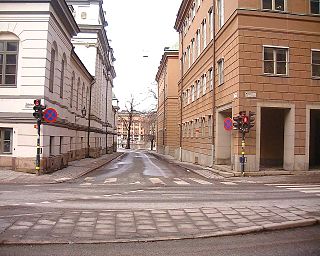
Rådhusgränd is an alley in Gamla stan, the old town in central Stockholm, Sweden. Stretching from the junction between the street Myntgatan and the square Riddarhustorget, and passing between the Bonde Palace and Kanslihuset, it leads north to the bridge Vasabron, while forming a parallel street to Riddarhusgränd. Along the waterfront north of the alley passes the quay Kanslikajen.

Tyska Skolgränd is an alley in Gamla stan, the old town in central Stockholm, Sweden, stretching from Svartmangatan to Baggensgatan, and crossed by Själagårdsgatan.

Tyska Stallplan is a street in Gamla stan, the old town in central Stockholm, Sweden. Stretching south from Svartmangatan to Prästgatan, it is connected to Baggensgatan and Mårten Trotzigs Gränd, while forming a (somewhat) parallel street to Österlånggatan and Tyska Brinken.

Riksgatan is a street in Gamla stan, the old town in central Stockholm, Sweden. Located on Helgeandsholmen, and passing between the eastern and the western buildings of the Swedish Parliament House, makes it the official address of the Parliament.



